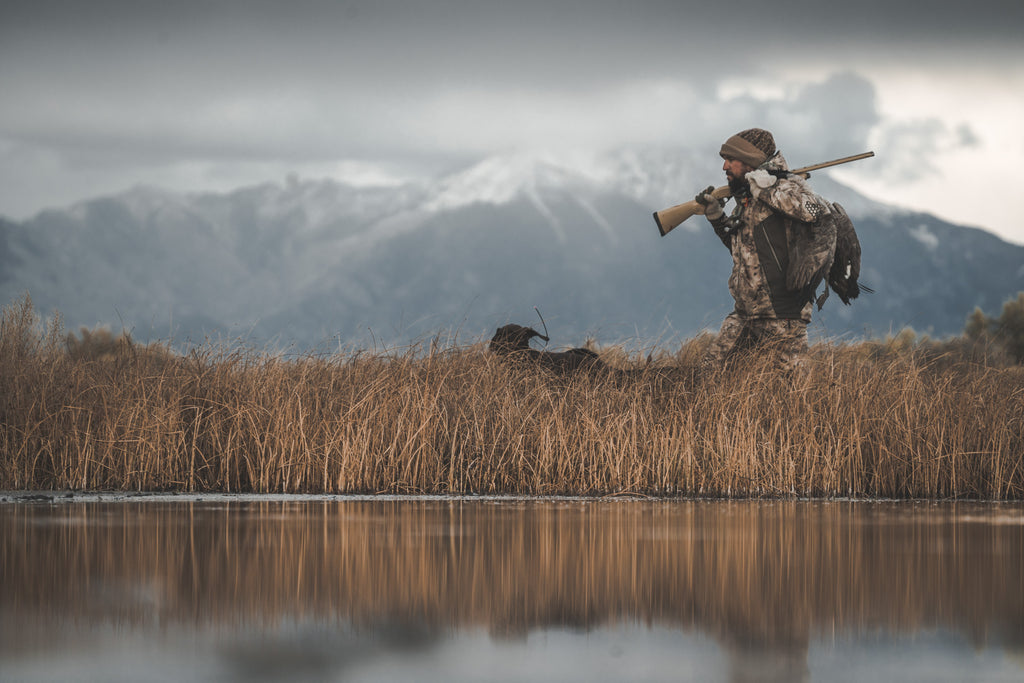Shotgun Shot Size

Shotgun Shot Size and Ballistics
Shotgun shot size is one of the most contested subjects on the internet when it comes to upland and waterfowl hunting. There are good arguments to be made all around, but how much does it really matter? With a plethora of available options on the sporting store shelves today, it is important to be educated and know what you are buying and why. Let’s take a look at the different shot sizes and how they perform in different scenarios.

How it’s Made
Lead shot is made by pouring molten lead through a perforated pan and allowing it to shower through. As it passed through the screen it immediately begins to cool but doesn’t fully cool until it falls into water. The size of the perforations in the pan or screen dictates the shot size. There are at-home shot pourers that are available to purchase if you are interested in making your own,

#8 Shot vs. #4 Shot
How is Shot Measured?
First, let’s get a base knowledge of where all these numbers come from. The numerical designation is given to the shot based on its diameter. A quick way of identifying the pellet diameter of your shot is to subtract the shot size from 17 and divide that by 100. For example, if we were to calculate the diameter of #6 shot it would look like this; 17 - 6 = 11 / 100 = .11” or “one-hundred and ten thousandths”. Beyond that it tends to be a little random.

The chart below is a good comparison of the size shot and the amount of pellets per ounce in each size. All of these calculations were done with the density of lead and may vary with other types of shot.
Shot Size Chart
|
Shot Size |
Pellet Diameter |
Pellets Per Ounce |
Weight Per Lead Pellet(Grains) |
|
9 |
.08 |
585 |
0.75 |
|
8 |
.09 |
409 |
0.97 |
|
7 1/2 |
.095 |
350 |
1.09 |
|
6 |
.11 |
223 |
1.62 |
|
5 |
.12 |
172 |
1.99 |
|
4 |
.13 |
136 |
2.58 |
|
2 |
.15 |
88 |
4.37 |
|
B |
.17 |
60 |
7.29 |
|
BB |
.18 |
50 |
8.75 |
|
BBB |
.19 |
43 |
10.17 |
|
T |
.20 |
37 |
11.82 |
|
TT |
.21 |
32 |
13.67 |
|
TTT |
.22 |
27 |
16.20 |
|
No. 4 Buck |
.24 |
21 |
20.83 |
|
No. 3 Buck |
.25 |
18 |
24.31 |
|
No. 2 Buck |
.27 |
14 |
31.25 |
|
No. 1 Buck |
.30 |
10 |
43.75 |
|
0 Buck |
.32 |
9 |
48.61 |
|
00 Buck |
.33 |
8 |
54.69 |
|
000 Buck |
.36 |
6 |
72.92 |
Shot Sizes and Their Uses
Just like everything in life, it’s a give-and-take scenario when it comes to shot size. The smaller the shot size the more pellets, therefore the more dense the pattern. Your range suffers, as does your knockdown power. Go to a larger size shot and you have less coverage in your pattern, but a more extended range and more knockdown power. As you can see, it is easy to overthink this.
The chart below is a good guide for the uses of each shot type. However, it is only a guide and is not set in stone. All shot sizes and uses are subjective to the location, shot range, early vs. late season, hunting pressure, and weather conditions. Hunting out here in the plains of Montana I routinely have multiple shot sizes in my bird vest, typically 7 ½ and 6 shot for my 16 gauge. This allows me to adapt to the situation as you never quite know what species you’ll run into hunting here.

Additionally, the field conditions matter. I’ll wrap location, season, and pressure into this one. If you're hunting sharptail out on the plains they might hold tight and flush at your feet or they might flush 40 yards ahead of you. In these situations I’ll usually carry multiple shot sizes to be able to adapt to any scenario. With the late season and more pressure, birds tend to flush further out, therefore it is better to go up in size. Everything larger than #2 shot is used for waterfowl and big game where legal.
Shot Size Use Chart
|
Shot Size |
Uses |
|
9 |
Small birds, Doves, Quail |
|
8 |
Doves, Quail, Ruffed Grouse, Pigeons, Woodcock |
|
7 1/2 |
Blue Grouse, Spruce Grouse, Ruffed Grouse, Sage Grouse, Sharptail Grouse, Hungarian Partridge, Pigeons, Woodcock |
|
6 |
Pheasant, Sage Grouse, Sharptail Grouse, Chukar |
|
5 |
Pheasant, Turkey, Waterfowl |
|
4 |
Turkey, Waterfowl |
|
2 |
Waterfowl |
Shot Ballistics
The ballistics of a shotgun is something that is widely misunderstood for the general bird or small game hunter. In my opinion, it is something that isn’t fully understood until the hunter has fired lots of shells at lots of animals. Most hunters would be shocked to see how fast velocity drops off when firing.
Let’s focus on the linear ballistics of the shot, ignoring its effects on the pattern as that is more conducive to choke size. If comparing a shotgun pellet to a rifle bullet it is easy to draw parallels for general rules of trajectory and killing power. Velocity and weight are the two biggest factors when looking at both of these rules as they both directly affect the energy on target. The heavier the projectile, the longer it travels and retains energy. The faster the shot leaves the barrel the more energy it carries with it.

The surprising part about shotgun ballistics is how much velocity is lost by the little ballistically inefficient shotgun pellets. The late Ed Lowry, the authority on shotshell ballistics, once published a velocity chart of different shot sizes and the results were very eye-opening. The standard pheasant or grouse load of #6 shot leaving the barrel at 1375 fps immediately begins to lose velocity. At 30 yards the velocity had already dropped off to 780 fps, while at 50 yards it was only 591 fps. It really makes you rethink those long shots in the uplands and gives you a good representation of why far more birds are wounded at those longer ranges.
The above data was published in 1989 in an American Rifleman, although it is over 30 years old the physics involved haven’t changed. Those tests were done with lead-shot which is heavier and denser than the non-toxic alternatives on the market, meaning those alternatives will lose velocity ever faster, something to consider if shooting non-toxic.
Bucking the Wind
Taking the wind into consideration when choosing your shot size is not something most eastern hunters are used to. Out on the high plains of the west, the wind is absolutely a factor. Hunting in 20-30 mph winds is pretty standard for mid-season hunting. In these scenarios, it is best to move up a shot size and use something a little bigger that won’t be as affected by the wind.

The weight of an individual shot pellet is pretty pathetic when doing a ballistics calculation. The average #7 ½ shot pellet weighs just 1.09 grains, while a #6 pellet weighs 1.62 grains. In relation to this equation, if you were headed out to hunt sharptail grouse and Hungarian partridge on a windy day you would be much better off shooting #6 shot as opposed to #7 ½ shot.
The Slug
A “slug” is essentially one pellet that fills the entire shotgun shell. This pellet is sometimes rifled to stabilize better. The slug is unique to each and every gauge. They all have varying sizes and weights dependent on the load. The slug is deadly at close range but tends to drop off in accuracy out past 100 yards. The trajectory of a slug is very rainbow like which lends it to be used where high powered rifles are restricted. Slug gun hunting opens up so many opportunities for the hunter and should not be overlooked.
So What’s the Best?
Take your shotguns out and pattern them with the different loads that you have and make a decision based on that. Some gauges can’t handle the larger shot sizes effectively and your groups will show that. Find the most effective ones and use them.

There is really no right answer to choosing which shot size is best. So much goes into that decision that you can almost talk yourself out of going hunting. While all of this information is a basis for making a decision, don’t stress out or overcomplicate it. Having a working knowledge of all of this will allow you to make an educated decision more confidently. In the end, a dead bird is a dead bird and it really doesn’t care whether it was hit with #5 or #6 shot.
Written by Kurtis Martonik
